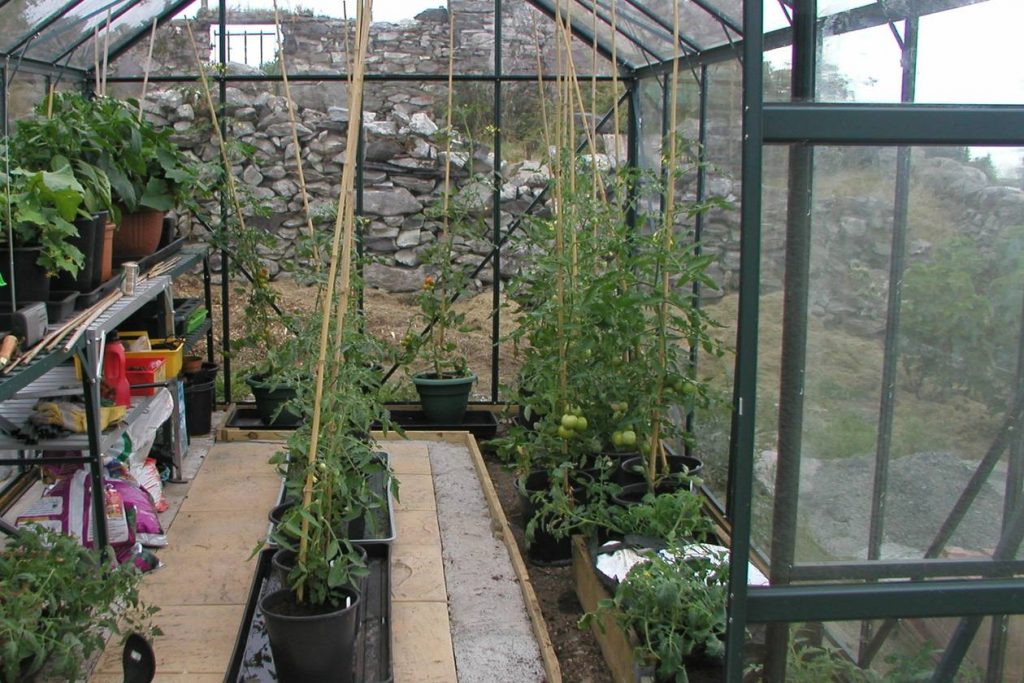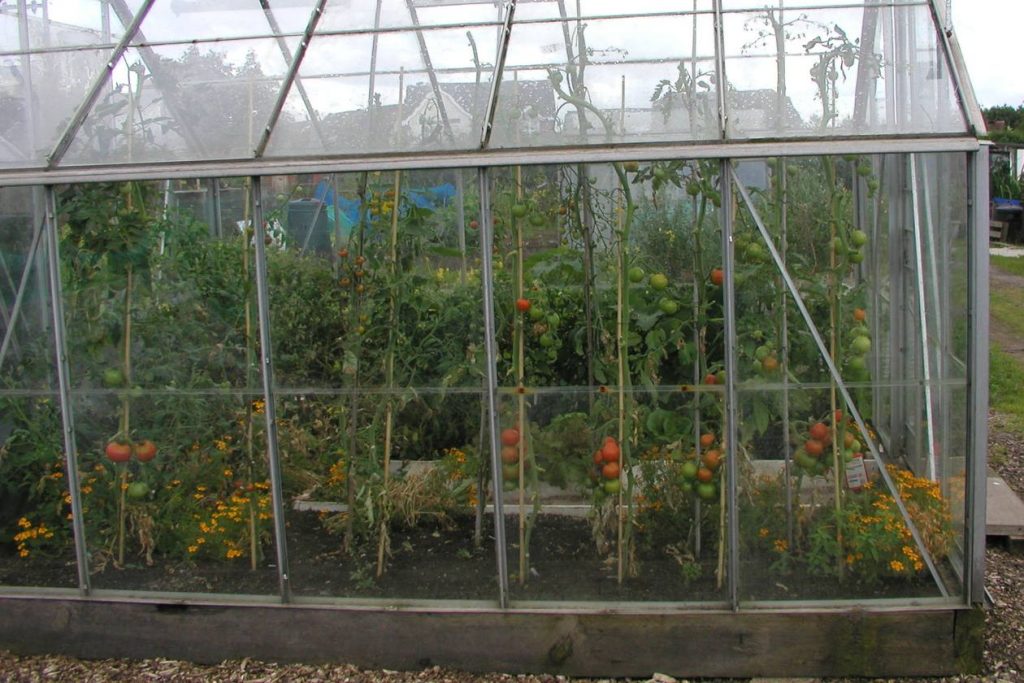It is certainly more natural to grow tomatoes in a border than in containers. But for me the big advantage of growing in a properly prepared border over containers is that it stores enough water that missing watering for a day isn’t a big problem.
 The problems that beset tomatoes due to irregular watering like split skins and blossom end rot are rare in border grown plants as are problems like magnesium deficiency as the larger volume of soil in a border is more forgiving of our mistakes – diluting fertiliser overdoses.
The problems that beset tomatoes due to irregular watering like split skins and blossom end rot are rare in border grown plants as are problems like magnesium deficiency as the larger volume of soil in a border is more forgiving of our mistakes – diluting fertiliser overdoses.
The disadvantages of growing in the border soil are these:
- Properly preparing the border soil can be quite a lot of work.
- The soil in the border will require changing to avoid a build up of diseases
- Pests like slugs can be lurking in the soil
- Weeds growing in the soil
- Evaporation from the border soil increasing humidity beyond what you want
Luckily the last three points can be overcome quite easily but preparing and changing the soil is still a task to consider.
Preparing the Greenhouse Border Soil
The ideal tomato border will provide nutrients for the plants and retain water without becoming waterlogged.
In winter or very early spring, dig out the existing soil, at least a spade depth or more if you can. Break up the sub-soil at the bottom with a fork.
Next add a thick layer of home made compost – at least 6” deep but more is better if you can. If you have wood ashes available, add an ounce per square foot or a tenth of that amount of sulphate of potash.
An ounce of calcified seaweed per square foot will assist microbial action in the soil.
Top off with a layer of sieved garden soil mixed with commercial multi-purpose compost or leafmould. The bed should be mounded and high at this stage. Over the next months the bed should sink. If it is low at planting time, add some more soil / compost mix.
One serious tomato grower reckons his success is due in part to putting a layer of sheep manure in at the base of the greenhouse border with the compost. Sheep manure is high in potash compared with other animal manures.
Ideally you should repeat this process every year, digging out the old soil for use in the garden. In practice you can get away with every other year so long as you use more liquid feed such as comfrey liquid or commercial tomato feed to compensate for the nutrients having been used.
Do not use the soil removed from the greenhouse border on a potato bed – these are the same family as tomatoes and use similar nutrient ratios.
Pest and Disease Problems in Greenhouse Borders

Tomatoes in Greenhouse Border viewed from outside the greenhouse. Note the marigolds to repel whitefly inter-planted.
The biggest pest problem has to be slugs and snails. These are easily dealt with by using beer traps or safe slug pellets. Personally I prefer the pellets but just use whatever method you prefer.
If the soil hasn’t been changed as described above for a few years you will get problems of diseases building up and nutrient deficiencies developing.
Some growers swear by sterilising the soil in the greenhouse border by drenching with dilute Jeyes Fluid or the like. This will kill any latent disease but at the cost of killing all the microbes and worms. Friend and foe alike will be killed.
The complex natural system which helps plants absorb nutrients is wiped out. I have seen no trials or studies but I strongly suspect the vitamin content of the fruits will be lower and flavour inferior.
Weeds & Evaporation Causing too much Humidity
Just as on the plot, weeds are easily handled when small. Once they grow pulling them can damage the roots of your tomatoes.
If, instead of just watering the surface you insert half bottles into the soil and water into those, the surface will remain dry but the tomatoes will have water. The dry surface will stop any weed seeds germinating and prevent evaporation increasing humidity.
Do not use black or clear plastic as this can over-heat and cook the plant roots, killing your crop.
You can water through bottles as mentioned above or use a drip hose under the plastic to water.
Further Information: Tomato Growing Guides
- Grow Unusual Tomatoes!
- Types of Tomatoes – An Introduction to Tomato Growing Part 1
- Sowing and Starting off Tomatoes – Introduction to Tomato Growing Part 2
- Growing Tomatoes in a Tomato Grow-house (Mini-Greenhouse)
- Growing Tomatoes in a Greenhouse
- Growing Tomatoes in the Greenhouse Border
- Growing Tomatoes in Pots or Grow Bags in the Greenhouse
- Growing Tomatoes by Ring Culture
- Growing Tomatoes in Straw Bales
- Growing Tomatoes Outdoors
- Planting & Growing Tomatoes Outdoors
- Growing Patio Tomatoes – Dwarf Bush Variety Patio Tomatoes
- Water Requirements for Tomatoes
- Ideal Temperatures for Growing Tomatoes
- Removing Tomato Side Shoots (Suckers) & Stopping Tomatoes
- Best Tomato Varieties – My Top Tasty Tomato Picks
- Heirloom Tomatoes (Heritage Tomatoes)
- Best Tomatoes for Greenhouse Growing
- Tomato Troubles & Diseases | Causes & Cures of Tomato Problems
- Raising Tomato Plants from Seed



